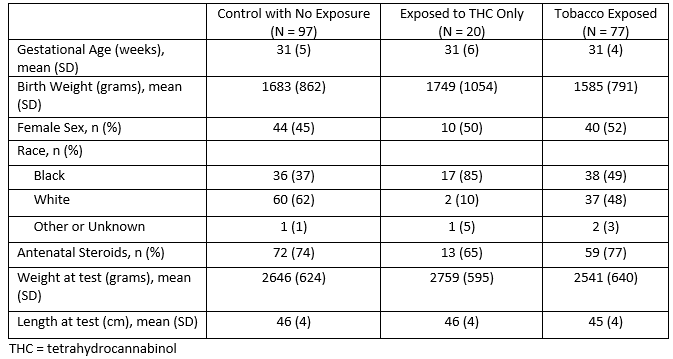Neonatal General 12: Prenatal Exposures
Session: Neonatal General 12: Prenatal Exposures
426 - Evaluating Effects of Prenatal THC and Tobacco Exposure on Neonatal Lung Mechanics
Monday, April 28, 2025
7:00am - 9:15am HST
Publication Number: 426.5077
Erin N L. Thrasher, University of Alabama School of Medicine, Irondale, AL, United States; Kimberly Armstead, University of Alabama School of Medicine, Birmingham, AL, United States; Viral Jain, University of Alabama School of Medicine, Birmingham, AL, United States; Colm P. Travers, UAB, Birmingham, AL, United States
- ET
Erin N L Thrasher, MD (she/her/hers)
Neonatology Fellow
University of Alabama School of Medicine
Irondale, Alabama, United States
Presenting Author(s)
Background: Prenatal exposure to tetrahydrocannabinol (THC) is increasing in the United States. THC exposure may adversely impact lung health in adults. While prenatal tobacco exposure is associated with adverse effects on infant lung health, the effect of THC exposure on infant lung health is not known.
Objective: Test the hypothesis that exposure to prenatal THC and/or tobacco will adversely affect lung mechanics in term and preterm infants compared with infants without known exposure.
Design/Methods: This is a secondary analysis of a single center study of non-invasive impulse oscillometry (iOS) including infants from 22-42 weeks of gestational age (GA) at the University of Alabama at Birmingham. Infants with congenital malformations or syndromes affecting respiration were excluded. Pulmonary mechanics were obtained using the tremoflo N-100 (Thorasys, Montreal) at 40 weeks’ postmenstrual age or discharge. Infants were categorized as THC exposed based on a positive maternal urine drug screen or maternal self-report of use during pregnancy. Infants were categorized as tobacco exposed based on self-report of use during pregnancy. Control infants had no known exposure to THC or tobacco and were matched 1:1 based on gestational age at birth. The primary outcome was the difference in the area under the reactance curve (AX), a measure of overall lung stiffness. Secondary outcomes included the difference between peripheral and central resistance (R7-19), peripheral reactance (X7), and overall resistance (R7). Data were analyzed using single factor ANOVA test, and a p < 0.05 was considered significant.
Results: We included 194 infants of whom 20 (10.3%) were exposed only to THC, 77 (39.7%) were exposed to tobacco, and 97 (50%) were not exposed. The GA, birth weight, and the weight and length at time of testing did not differ between groups (Table 1). AX, X7, and R7-19 did not differ significantly between groups (Table 2). Infants exposed to tobacco had higher R7 compared with controls and THC exposed infants suggesting higher overall resistance of the respiratory system (p=0.049).
Conclusion(s): In our study, prenatal exposure to THC did not adversely affect lung mechanics in infants. As anticipated, prenatal tobacco exposure was associated with worse lung mechanics with higher overall resistance. Our data suggest that while prenatal tobacco may be a risk factor for lung disease, prenatal THC exposure may not increase the risk of lung disease in infants.
Table 1
 Baseline characteristics of infants with no exposure to THC or tobacco, infants exposed only to THC, and all infants exposed to tobacco who underwent oscillometry testing.
Baseline characteristics of infants with no exposure to THC or tobacco, infants exposed only to THC, and all infants exposed to tobacco who underwent oscillometry testing. Table 2
 Lung mechanics in infants with no exposure to THC or tobacco, infants exposed only to THC, and all infants exposed to tobacco. AX = area under the reactance curve, X7 = reactance at 7Hz, R7 = resistance at 7 Hz, R7-19 = the difference between R7 and resistance at 19 Hz.
Lung mechanics in infants with no exposure to THC or tobacco, infants exposed only to THC, and all infants exposed to tobacco. AX = area under the reactance curve, X7 = reactance at 7Hz, R7 = resistance at 7 Hz, R7-19 = the difference between R7 and resistance at 19 Hz.
